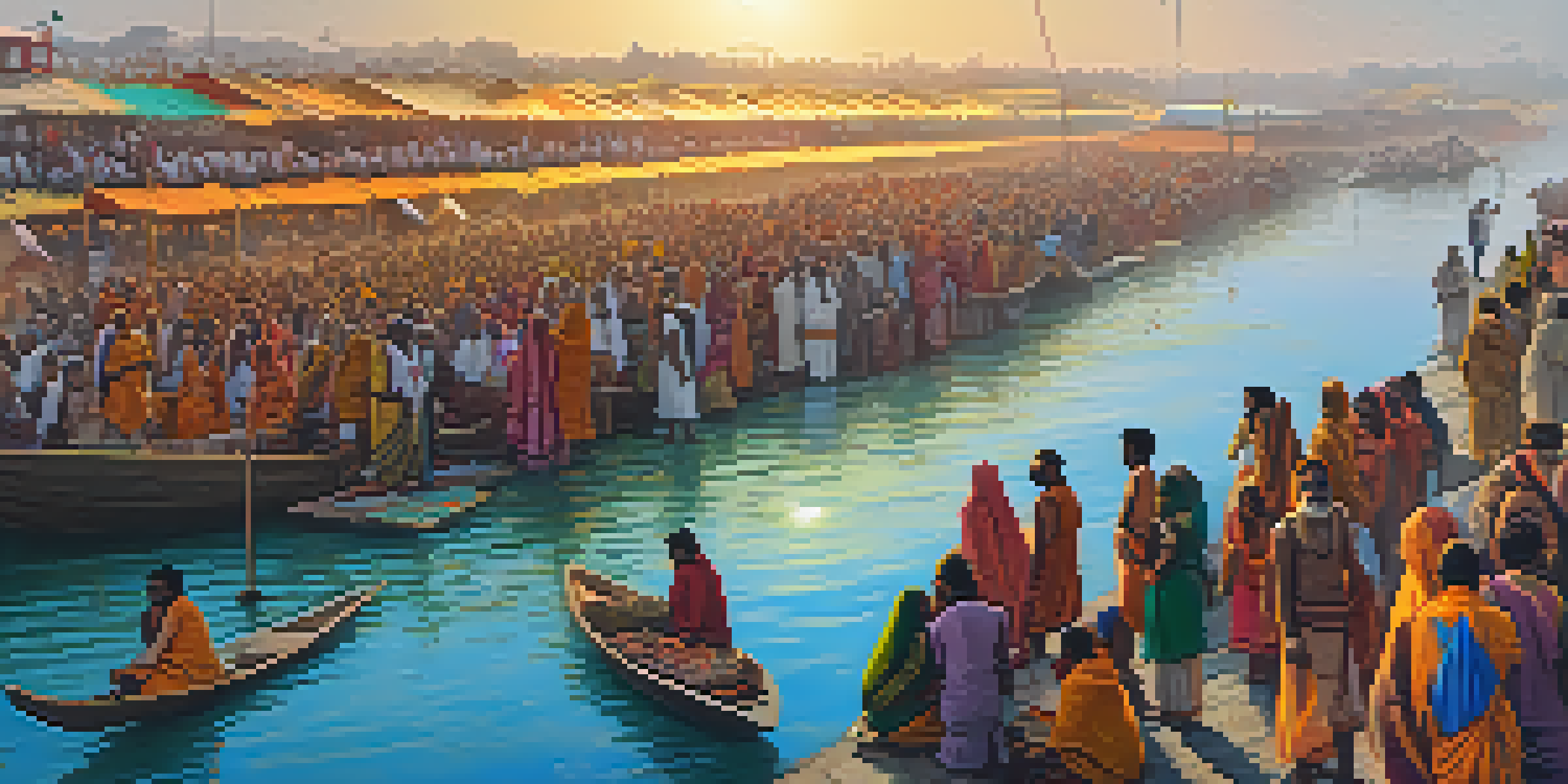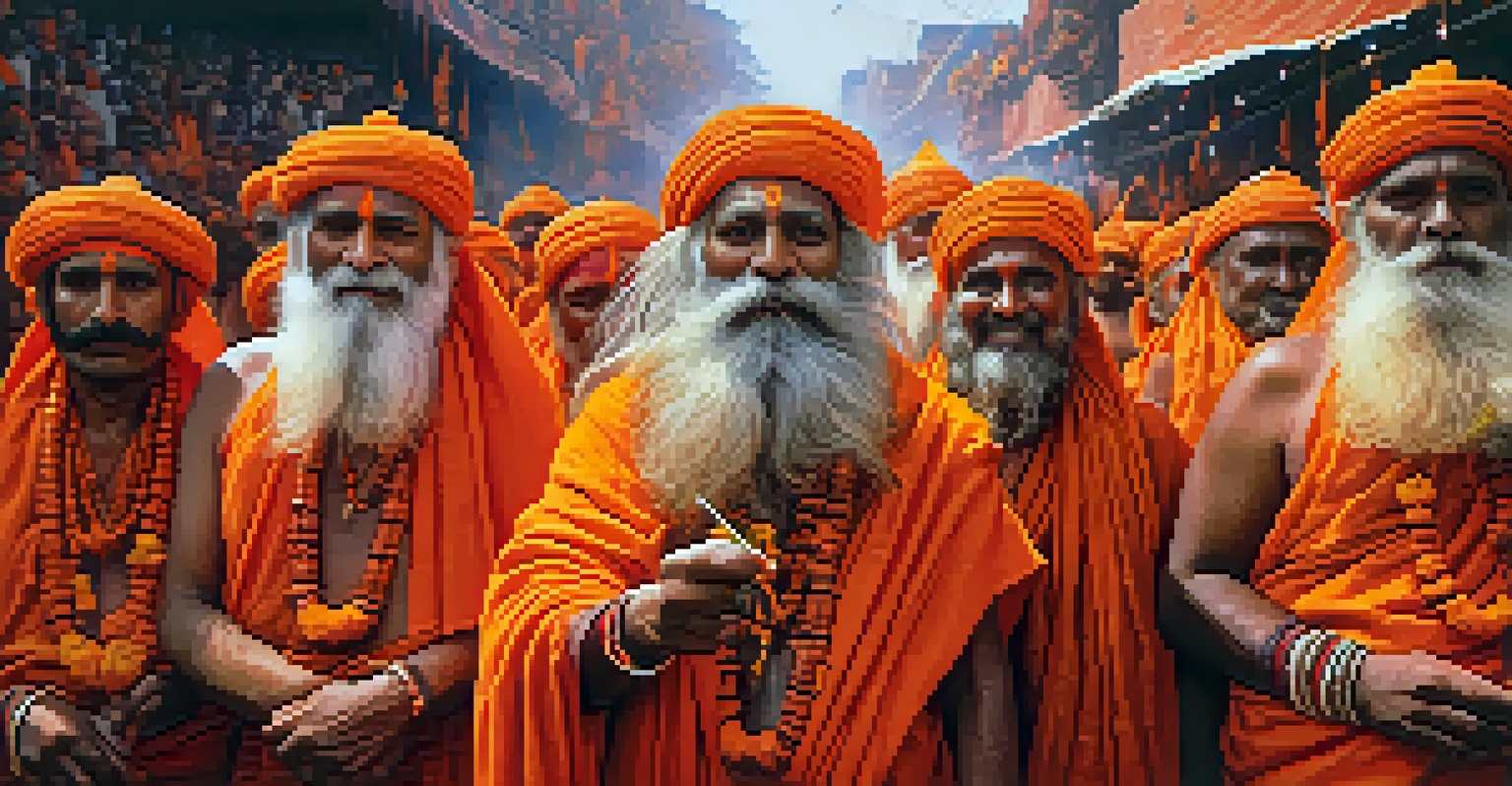The Ancient Route of the Kumbh Mela: A Pilgrimage Journey

Understanding the Kumbh Mela: A Spiritual Gathering
The Kumbh Mela is one of the largest religious gatherings in the world, attracting millions of pilgrims to various sacred sites in India. This festival is celebrated every three years, rotating among four holy cities: Haridwar, Allahabad (Prayagraj), Nashik, and Ujjain. The event is steeped in mythology, originating from the cosmic battle between gods and demons over a pot of nectar, or 'amrit'.
The journey of a thousand miles begins with one step.
Each location of the Kumbh Mela is believed to have unique spiritual significance, making the pilgrimage a deeply personal journey for many. For instance, the confluence of the Ganges, Yamuna, and mythical Saraswati rivers at Prayagraj is particularly revered. This sacred spot is considered an ideal place for cleansing one's sins and attaining spiritual liberation.
With such rich history and spiritual importance, the Kumbh Mela is not just a festival; it’s an experience that connects individuals with their cultural and spiritual roots, fostering a sense of community and devotion.
The Path of Pilgrimage: Routes to the Kumbh Mela
The ancient routes leading to the Kumbh Mela are as significant as the event itself. Pilgrims often embark on long journeys, whether on foot, by train, or bus, traversing through scenic landscapes and towns steeped in history. Each route carries its own stories and traditions, enriching the pilgrimage experience.

For instance, many devotees choose to walk significant distances, symbolizing their dedication and penance. This journey can take days, even weeks, reflecting the deep spiritual commitment that participants hold. Along the way, they encounter other pilgrims, forming bonds that transcend geographical and cultural boundaries.
Kumbh Mela: A Spiritual Journey
The Kumbh Mela is a significant religious gathering that connects millions of pilgrims with their spiritual roots across four holy cities in India.
The excitement builds as pilgrims approach the holy site, with anticipation in the air. This shared journey creates a unique sense of unity and purpose, reminding everyone that they are part of something much larger than themselves.
Preparation for the Journey: Mind, Body, and Spirit
Preparing for the Kumbh Mela pilgrimage is essential, requiring a balance of physical readiness and spiritual mindset. Many participants engage in rituals and practices to purify themselves before the journey begins. This may include fasting, meditating, and performing daily prayers to seek blessings.
We are all pilgrims on the same journey, but some of us are in different vehicles.
Physical preparation often involves training for the long walks ahead. Many pilgrims practice endurance by hiking in local parks or taking up yoga to enhance flexibility and strength. This combination of physical and spiritual preparation sets the tone for the journey, ensuring that pilgrims are ready to embrace the challenges along the way.
Ultimately, the journey is about more than just reaching the destination; it’s about cultivating a mindset of devotion and resilience that will carry them through the experience.
Cultural Significance: Traditions and Practices
The Kumbh Mela is a vibrant tapestry of cultural traditions and practices, with each region contributing its unique flavors. From colorful processions adorned with flowers to chanting of sacred mantras, the event is filled with rituals that honor the divine. Pilgrims often participate in sacred baths, believed to cleanse the soul and wash away sins.
Different sects and communities have their own customs, adding layers of diversity to this grand festival. For example, the Naga Sadhus, or ascetic holy men, participate in a grand procession, showcasing their commitment to a life of renunciation. Their presence adds a dramatic flair to the event, captivating the attention of many.
Community Spirit at Kumbh Mela
The event fosters a sense of community among pilgrims, encouraging camaraderie and support through shared experiences and communal practices.
Through these traditions, the Kumbh Mela serves as a vibrant expression of India's rich cultural heritage, fostering respect and understanding among diverse communities.
The Role of Community: Bonding Among Pilgrims
One of the most beautiful aspects of the Kumbh Mela is the sense of community that blossoms among pilgrims. As individuals gather from various backgrounds, their shared purpose creates an atmosphere of camaraderie and support. It's not uncommon for strangers to bond over their experiences, sharing stories and encouragement along the way.
Food stalls and communal kitchens, known as langars, are set up to feed the hungry, emphasizing the importance of hospitality and generosity. This spirit of sharing enhances the sense of belonging, making everyone feel welcome, regardless of their background. Many pilgrims often recount how these interactions transformed their pilgrimage into a more profound journey.
In essence, the Kumbh Mela encapsulates the idea that spirituality is not just a solitary endeavor; it thrives within community and connection, enriching the experience for everyone involved.
The Pilgrimage Experience: Challenges and Triumphs
While the Kumbh Mela is a spiritual highlight for many, the journey is not without its challenges. The sheer number of people can lead to crowded conditions, and navigating through the throng can be daunting. Pilgrims often encounter logistical hurdles, from securing accommodation to managing transportation amidst the chaos.
However, these challenges often become part of the pilgrimage narrative. Many pilgrims share stories of how they overcame obstacles, turning potential frustrations into moments of growth and resilience. It's not uncommon for individuals to find strength in adversity, emerging from the experience with newfound wisdom.
Challenges Shape the Pilgrimage
Despite the challenges faced during the pilgrimage, such as crowded conditions, many find personal growth and resilience through their experiences.
Ultimately, the journey underscores a vital lesson: that the path to spiritual fulfillment may be fraught with difficulties, but overcoming them can lead to profound personal transformation.
Reflections After the Pilgrimage: Lessons Learned
After completing the Kumbh Mela pilgrimage, many participants find themselves reflecting on their experiences and the lessons learned along the way. The journey often brings a sense of peace and spiritual awakening, allowing individuals to reconnect with their purpose and values. Conversations with fellow pilgrims can spark new insights and perspectives.
For some, the Kumbh Mela becomes a turning point in their lives, motivating them to adopt more spiritual practices or embrace a lifestyle centered around community service. The bonds formed during the pilgrimage often lead to lifelong friendships and networks that continue to inspire.

In this way, the Kumbh Mela is not merely an event but a transformative experience that echoes in the lives of those who partake, reminding them of the beauty of faith, community, and perseverance.